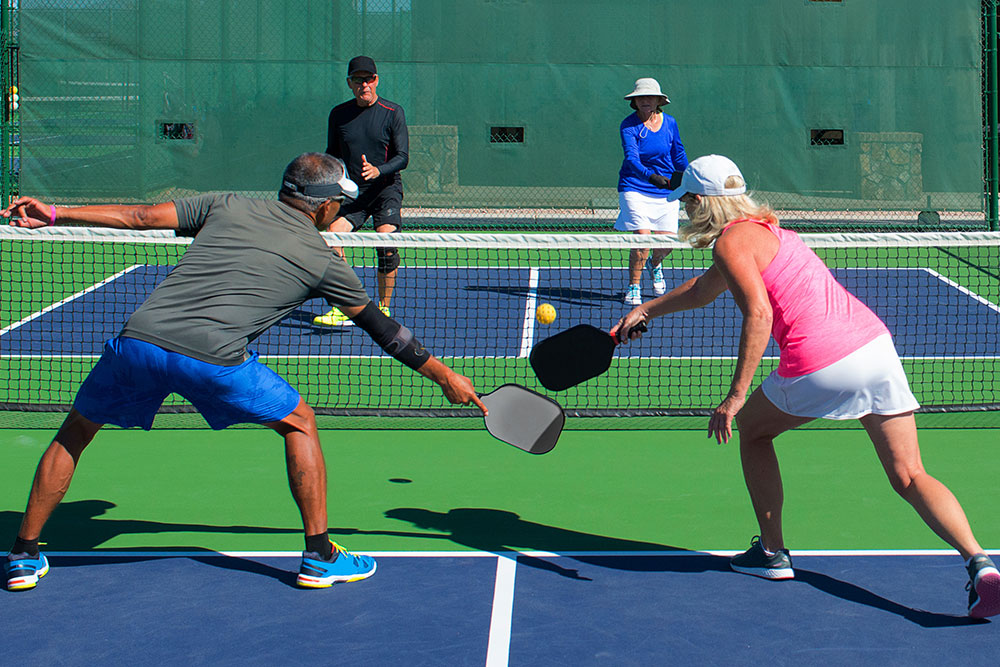
Pickleball is one of the fastest growing sports in the United States. One of the biggest appeals to the sport is that it is low impact and relatively easy to learn – making it especially attractive to the 55 and older population. However, due to the quick side to side movements and sudden stops and starts, pickleball injuries are on the rise.
Richard Cunningham, MD, a top orthopedic surgeon with over two decades of experience, sheds light on the most common injuries in pickleball and offers insights into prevention, treatment, and long-term recovery strategies.
Understanding Pickleball Injuries
Pickleball – a fast-paced paddle sport – shares similarities with tennis, badminton, and table tennis. Despite its relatively low-impact nature, pickleball players are not immune to injuries. Dr. Cunningham emphasizes, “The most common injury in pickleball is typically related to overuse and repetitive strain on the joints and muscles, particularly in the shoulder, elbow, and knee areas.”
Risk Factors and Prevention
Engaging in repetitive motions without proper conditioning and warm-up significantly increases the risk of pickleball injuries. Dr. Cunningham highlights the importance of preventive measures stating, “To mitigate the risk of pickleball injuries, players should prioritize adequate warm-up exercises, maintain proper form, and incorporate cross-training activities to enhance overall strength and flexibility.”
Common Ways Pickleball Injuries Occur
Pickleball injuries often result from sudden movements, awkward landings, or abrupt changes in direction during gameplay. “Common scenarios leading to pickleball injuries include quick pivots, reaching for difficult shots, and collisions with teammates or equipment,” said Dr. Cunningham.
Immediate Treatment and Long-Term Recovery
In the event of a pickleball injury, prompt medical attention is important. Dr. Cunningham advises, “Immediate treatment may involve rest, ice, compression, and elevation (RICE), along with over-the-counter pain medications. However, for more severe injuries, such as ligament tears or fractures, seeking orthopedic evaluation is imperative.”
Long-term recovery from pickleball injuries often require a comprehensive rehabilitation program tailored to the individual’s specific needs. Dr. Cunningham said, “rehabilitation may include physical therapy, targeted exercises, and a gradual return to activity to ensure optimal recovery.”
When Conservative Treatment Fails
In cases where conservative measures fail to alleviate symptoms or restore functionality, Dr. Cunningham recommends exploring alternative treatment options, such as minimally invasive procedures or surgical interventions particularly for ligament or tendon tears. He advises, “When conservative treatment fails to yield satisfactory results, I would recommend one consult with a qualified orthopedic specialist to explore treatment options.”
Avoiding Reinjury
Preventing reinjury is paramount for pickleball enthusiasts eager to return to the court, especially if dealing with an overuse injury. “To avoid reinjury, it’s important to respect the body’s healing process, gradually reintroduce activity, and prioritize ongoing strength and conditioning to enhance resilience,” said Dr. Cunningham.
While pickleball offers a myriad of physical and social benefits, it’s essential to approach the sport with some caution and mindfulness towards injury prevention. As players strive for peak performance on the court, prioritizing safety and well-being remains paramount. If you have suffered from a knee, or shoulder injury during pickleball, reach out to Dr. Cunningham and his team today by requesting a consultation.
